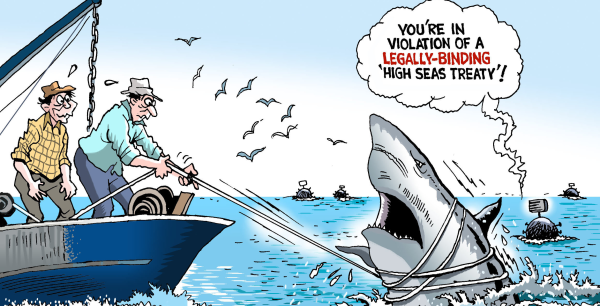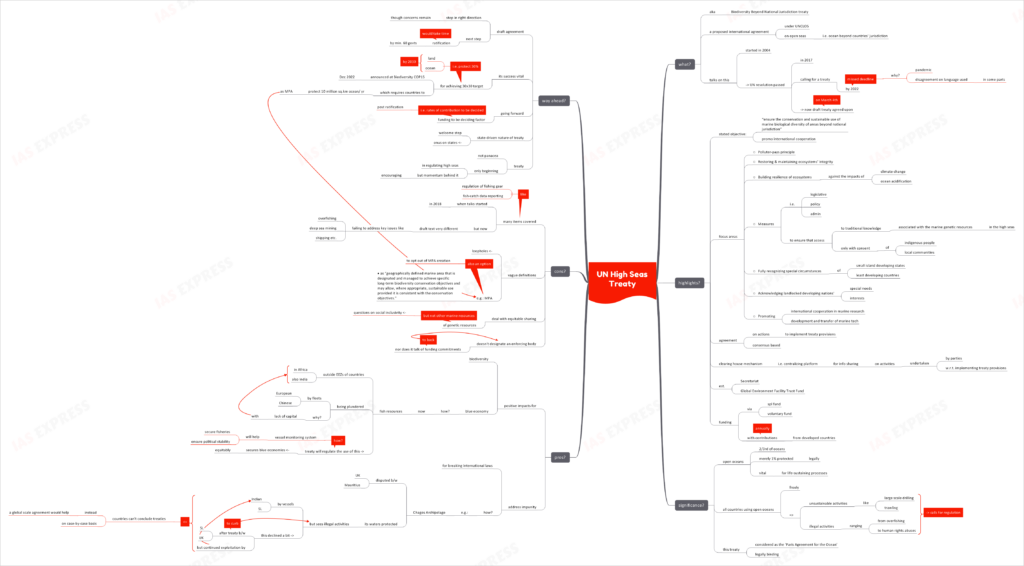UN High Seas Treaty- Highlights, Significance, Pros & Shortcomings

From Current Affairs Notes for UPSC » Editorials & In-depths » This topic
IAS EXPRESS Vs UPSC Prelims 2024: 85+ questions reflected
On March 4th, the draft UN High Seas Treaty was finalized. This international agreement is set to tame the last frontier for unregulated anthropogenic activities- the international oceans.

What is the UN High Seas Treaty?
- The UN High Seas Treaty, also known as the Biodiversity Beyond National Jurisdiction (BBNJ) Treaty, is a proposed international agreement governing the open seas i.e. a vast majority of the oceans that lie beyond individual national governments’ jurisdiction.
- This treaty is being considered under the 1982 UNCLOS framework that governs the countries’ rights over marine resources.
- Talks started as early as 2004. In 2017, a UN resolution was passed, setting 2022 as the deadline for bringing in a treaty for conserving oceans’ health.
- However, the pandemic and the disagreements over the language used in parts of the draft led to the 2022 deadline being missed.
Highlights:
- The 54-pade draft document’s stated objective is to “ensure the conservation and sustainable use of marine biological diversity of areas beyond national jurisdiction” and to promote international cooperation.
- Some of the focus areas of the draft are:
- Polluter-pays principle
- Restoring and maintaining ecosystems’ integrity
- Building resilience of ecosystems against the impacts of climate change and ocean acidification
- Measures- legislative, policy and administrative- by the treaty parties to ensure that access to traditional knowledge associated with the marine genetic resources in the high seas is only with the free, prior and informed consent of the indigenous people and the local communities
- Fully recognising the small island developing states’ and the least developing countries’ special circumstances
- Acknowledging the special needs and interests of landlocked developing nations
- Promoting international cooperation in marine research and development and transfer of marine tech
- Agreement on actions towards the treaty’s objectives is to be based on consensus.
- A clearing house mechanism is to be used in which a centralized platform will allow the parties to access and provide information on activities being undertaken in relation to the treaty.
- The treaty is to establish a Secretariat and a Global Environment Facility Trust Fund.
- Funding, via a special fund and a voluntary fund, would be provided to developing states to help with the treaty’s implementation. Developed countries are to make annual contributions towards this.
Why is it significant?
- Opens seas form 2/3rd of the world’s oceans. A mere 1% of them are legally protected.
- As all countries are currently allowed free access to these waters, there is now unsustainable levels of large-scale drilling and trawling activities for harvesting fish and other marine animals.
- Though high seas are vital for multiple live-sustaining environmental processes, it is also the scene of some of the most blatant illegal behaviours- ranging from over-fishing to human rights abuses. Alongside these, the seas are also being subject to land-based pollution and climate change. Hence, there is a pressing need for regulation.
- This treaty is being considered as the ‘Paris Agreement for the Ocean’.
- It is to be legally binding.
What are the pros?
- Apart from its positive impacts on biodiversity, the treaty is also expected to have economic benefits as well.
- For instance, the marine fish resources outside Africa’s EEZs are now mainly plundered by European fleets, as African countries lack sufficient capital to do so. A similar situation is faced by India, with European and Chinese fleets overfishing the high seas near the sub-continent.
- The BBNJ treaty would regulate fishing in these areas and help secure countries’ blue economies equitably.
- The treaty would back vessel monitoring in the high seas. Though many vessels have this system even now, it is frequently disabled to allow illegal movement and operations in the high seas.
- If such systems are used more widely, it would be a turning point- in securing fisheries as well as political stability.
- At present, the consequences for breaking international laws at sea vary. The BBNJ treaty would change this.
- For instance, the Chagos Archipelago in the Indian Ocean is a disputed territory between Mauritius and UK.
- Though its waters have been declared a protected zone, its remoteness, along with the small local population and muted local fishing activities, has made it a prime spot for illegal fishing, especially by fishers from Sri Lanka and India.
- Recently, UK and Sri Lanka concluded an agreement to boost monitoring and increase penalties for illegal fishing by Sri Lankan boats. This helped reduce such activities.
- However, as no such treaty exists between India and UK, Indian vessels continue to harvest even threatened species like sharks, with minimum consequences.
- A treaty on global scale would help eliminate the countries’ need to negotiate and conclude bilateral agreements on a case-by-case basis and plug these legal holes.
What are the shortcomings?
- When the negotiations started in 2018, the draft treaty sought to regulate the use of fishing gear, facilitate fish-catch data reporting and address multiple other issues plaguing the high seas. However, the final draft that was recently agreed upon looks very different.
- It fails to address several key threats affecting biodiversity in the high seas, such as deep-sea mining, shipping, overfishing, etc.
- It gives vague definitions that could lead to loopholes. For instance, it defines marine protected areas (MPAs) as “geographically defined marine area that is designated and managed to achieve specific long-term biodiversity conservation objectives and may allow, where appropriate, sustainable use provided it is consistent with the conservation objectives.”
- The treaty fails to designate a suitable international enforcement agency for enforcing the treaty provisions. Such a body would also need financial commitment- something that hasn’t featured in the talks.
What is the way ahead?
- This agreement on the draft text of the treaty is a significant step in the right direction, though some concerns remain.
- The next step is ratification by the individual countries’ governments, something that would take time (eg: Paris Agreement was adopted in 2015 but it came into force only in 2016). A minimum of 60 countries need to ratify the treaty for it to come into force.
- The treaty’s success is key to achieving the 30×30 target- i.e. protecting 30% of land and ocean by 2030- announced at the Biodiversity COP15 in December 2022. To achieve this target, the countries would need to bring 10 million sq.km. of ocean under protection every year.
- Going forward, the funding contributions is expected to be a deciding point in the treaty’s successful implementation. While the agreement establishes that developed nations would be making annual contributions, the rates are to be decided following the treaty’s ratification.
- The fact that many of the treaty’s parts are state-driven is a step in the right direction. The onus will be on the state parties to fulfil international obligations of marine biodiversity conservation.
- The BBNJ Treaty can’t be a panacea for all the issues plaguing the high seas. It is only the beginning of a long journey in regulating international oceans. However, the growing momentum behind this landmark treaty is encouraging.
Conclusion:
The draft treaty has been agreed upon after nearly 2 decades of talks and amid multiple conflicting interests and disagreements. It is a ‘victory in multilateralism’ as termed by the UN Secretary-General. However, its success depends on widespread ratification and efforts to implement its provisions in keeping with the spirit of the treaty’s objectives. It can be seen as the starting step in our journey to conserve the high seas.
Practice Question for Mains:
What is the UN High Seas Treaty? Discuss its positives and shortcomings. What is the way ahead? (250 words)
If you like this post, please share your feedback in the comments section below so that we will upload more posts like this.

